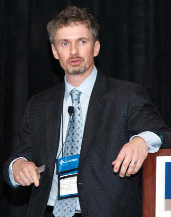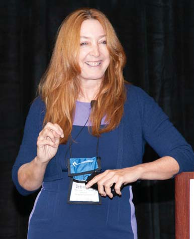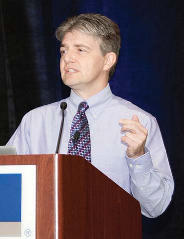Customizing Canine Care - Updates Presented at the 2013 National Parent Club Canine Health Conference
Success stories in recent canine health research embrace an individual, or customized, approach to treating disease. Adult stem cells and platelet-rich plasma provide the rich healing properties needed for soft-tissue injuries, and gene expression profiling is leading us to the day when cancer treatment can be targeted to individuals.
Although the variable penetrance of inherited cardiomyopathies dilutes the reliability of some DNA mutation tests, when these tests are combined with health testing, they are useful tools for determining the best therapy and breeding decisions. “As we develop genetic tests, we want black-and-white tests, but that doesn’t always happen,” says Kathryn Meurs, D.V.M., Ph.D., DACVIM, associate dean of research and graduate studies at North Carolina State University College of Veterinary Medicine.
The ninth biennial AKC Canine Health Foundation National Parent Club Canine Health Conference sponsored by Purina brought together leading canine clinicians and research scientists and parent club representatives in August in St. Louis for a review of many health topics. Scientific presentations included cataracts, epilepsy, bloat, gastroenterology, and physical therapy for dogs. Purina has sponsored the conference since its beginning in 1995. Here is a recap of some of the talks.
The Variability of Heart Disease
Variable penetrance helps to explain why some dogs with a gene mutation for an inherited cardiomyopathy get sick and others do not. These complex diseases of the heart muscle vary among, even within, breeds.
Meurs discovered the mutations for arrhythmogenic right ventricular cardiomyopathy (ARVC) in Boxers and dilated cardiomyopathy (DCM) in Doberman Pinschers. She continues to study both diseases.
“Variable penetrance is poorly understood,” Meurs says. “It likely involves other genetic and environmental factors, such as a dog’s diet and daily activities. We can identify who has the mutation, but we cannot predict the penetrance.”
In Boxers, ARVC is an autosomal dominant disease with variable penetrance. A deletion occurs in a gene that produces striatin, a key binding protein of the cardiac desmosome responsible for the heart’s electrical functioning. Boxers that are homozygous, or inherit two copies of the mutation, appear to have a more severe form of the disease. Those that are heterozygous, or inherit one copy of the mutation, develop abnormal heartbeats but are more responsive to medications.
“At first the heart muscle is abnormal, but it still contracts well,” Meurs explains. “As the cells are replaced with fat, the electrical functioning doesn’t contract well. It is an adult-onset disease that occurs around 6 to 8 years of age, often after a dog has been bred.”
Seventy-two percent of Boxers have the mutation and will show signs of the disease. Holter monitor tests detect ventricular premature complexes (VPCs), a series of heartbeats without a corresponding pulse that occur when the heart’s lower right ventricle contracts earlier than it should, resulting in a decreased flow of blood to the brain and other vital organs. A prolonged run of VPCs can cause cardiac arrest and death.
Dilated cardiomyopathy affects 40 percent of Doberman Pinschers. Fifty percent die from sudden death due to ventricular arrhythmia, 33 percent of which had no prior sign of heart disease. “Affected dogs generally appear normal until they are 5 to 7 years old, when their heart muscle is no longer able to mask the disease,” says Meurs. “Congestive heart failure occurs when the diseased heart can no longer pump blood adequately to the body. Coughing and shortness of breath are signs of a dilated heart.”
Meurs discovered a mutation for the autosomal dominant disease with variable penetrance on chromosome 14 in the PDK4 mitochondrial gene. DNA that should encode for a mitochondrial protein responsible for moving energy into the heart and helping it work efficiently is missing in affected dogs.
“It is likely there are at least two mutations responsible for DCM in Dobermans,” says Meurs. “We are not sure if it is two diseases or the same disease with two forms. There is the enlarged heart form that causes congestive heart failure and the ventricular arrhythmia form that causes sudden death.”
Meurs cautions breeders that a negative genetic test for DCM in Dobermans or for ARVC in Boxers does not mean a dog will not develop the diseases. “While these tests are valuable tools, they are not predictive in all Boxer or Doberman populations,” she says. “Mutation testing can be used with health testing to make the best decisions. Each dog and each bloodline should be considered individually. Remember, dogs that carry these mutations also carry other important good genes that we do not want to lose from these breeds.”
Combining Regenerative Techniques
Canine athletes and active dogs are at increased risk for soft-tissue injuries. As they run, leap, jump and sprint, they can cause microtears to their tendons and ligaments. When a dog performs these activities repeatedly, further microtears can occur.
Tendons and ligaments are typically slow to heal and often heal by scar tissue rather than tissue regeneration. Scar tissue does not have the same properties as native tissue and is more vulnerable to reinjury. Unfortunately for these dogs, discomfort and lameness often become chronic. Regenerative medicine promotes healing by regeneration of tissues and offers hope that these dogs may return to their active lives.

Sherman O. Canapp Jr., D.V.M., CCRT, DACVS, DACVSMR, an orthopedic surgeon and sports medicine specialist at the Veterinary Orthopedic & Sports Medicine Group in Annapolis Junction, Md., explains, “Tissues involved in musculoskeletal injuries tend to lose their matrix elasticity and thus are predisposed to reinjury.”
In his practice, Canapp has successfully returned many dogs with ligament or tendon injuries to their full activities using regenerative medicine therapies. His treatment consists of combining adipose-derived stem cells (ADSC) or bone-marrow stem cells (BMSC) with platelet-rich plasma (PRP).
“Since these cells are obtained from the intended recipient, the risk of rejection and disease transmission is eliminated,” he says.
“Sophia,” a 20-month-old English Mastiff, was referred to Canapp for treatment of chronic swelling and lameness in her left hind leg after running with dogs at her day care. Canapp evaluated Sophia and reviewed her radiographs. An MRI (magnetic resonance imaging) confirmed his suspicion that Sophia had a disruption of her Achilles tendon. Canapp recommended regenerative medicine.
Adult stem cells were taken from adipose tissue, or fat, in Sophia’s abdomen. The tissue was sent to a regenerative medicine laboratory where the stem cells and other regenerative cells were isolated from the tissue and then cultured, or grown, to obtain between 5 to 10 million cells. At the same time the stem cells were collected, blood was taken to obtain the PRP.
While the cells were being cultured, Canapp prescribed a custom orthotic that limited the range of motion of Sophia’s hock to prevent additional strain on the injured tendon. “The most important thing was protecting the tendon from further breakdown,” Canapp says.
The laboratory sent the cultured cells to Canapp in an injectable matrix. Using ultrasound guidance, Canapp injected the cells directly into the injured area of Sophia’s tendon. Following the procedure, Sophia was enrolled in a rehabilitation program to promote the healing properties of the injected cells.
Six weeks later Sophia’s swelling was significantly improved, and she was bearing full weight on the injured leg. The range of motion allowed by the orthotic was increased to add biomechanical load to the tendon to help promote healing and strengthening.
As Sophia continued rehabilitation therapy, serial ultrasounds were performed to evaluate healing. At her 12-week recheck, the tendon was healed, and Sophia was bearing weight evenly on her hind legs. Her rehabilitation program then began to focus on strengthening and weaning her out of the orthotic. At the six-month recheck, Sophia had graduated from rehabilitation, her ultrasound showed a completely healed tendon, and her muscle mass was symmetrical in her hind legs. Sophia was released to full activity and has since returned to day care with no sign of ever being injured.
“There is scientific evidence that regenerative medicine therapies work,” Canapp says. “In our practice, we have successfully used these therapies since 2008 to treat various injuries. In our patients, we see a 90 percent success rate.”
Cytokines & Canine Nutrition
The important role of nutrition in promoting healthy immune function especially becomes apparent when problems occur. Chronic nutrient deficiency and chronic nutrient excess, as seen in canine obesity, negatively impact immune health and consequently a dog’s overall health.
“The immune system is all a twitter,” says Deborah S. Greco, D.V.M., Ph.D., DACVIM, Purina Senior Research Scientist. “Cytokines help the cells communicate. They are the substances secreted by specific cells that carry signals between cells and have an effect on other cells. They are the Twitter of the immune system.”

Cytokines are proteins, peptides or glycoproteins that help regulate cell signaling. They are responsible for how a cell responds to infection, an immune attack, inflammation and even trauma. Research has shown that nutrient metabolism and immunity have evolved to share organ systems and signaling pathways, essentially being hardwired molecularly.
“Obesity is an inflammatory state characterized by the overproduction of inflammatory cytokines,” Greco explains. “For example, leptin, a messenger from fat to the brain to stop eating, is missing in dogs with obesity. Instead, these dogs have leptin resistance and never get the signal to reduce their appetite despite being overweight or obese.”
Chronic obesity can lead to metabolic disorders, such as insulin resistance caused by pro-inflammatory cytokine. Insulin resistance prevents glucose from getting into a cell by blocking the post-receptor message of the insulin receptor. “The good news is that this relationship also can be used to proactively enhance immune health,” Greco says.
A dog’s life stage has a huge impact on his immune status and is one of the most important reasons to consider nutritional strategies to boost immune system effectiveness. For example, good immune health can positively affect brain aging and cognition. When it is compromised, it causes distress. Repeated immune activation to combat infection can be a significant drain on metabolic resources and compete with energy-demanding processes like growth, reproduction and lactation.
“The gut is the largest immune organ, containing over 65 percent of all immune cells in the body,” Greco says. “Thus, a significant part of the immune system interacts with what we feed our dogs.”
Basic nutrition that includes optimal key nutrients is critical for healthy immune function. Dogs should be fed diets containing high levels of high-quality protein because protein makes up the structural components and mediates key processes of the immune system.
“It is no surprise that chronic nutrient deficiency or excess can negatively impact immune health and overall health,” Greco says. “Feeding dogs an optimal complete and balanced diet with high-quality protein is important.”
The Future of Cancer Treatment
Cancer researcher Jaime Modiano, V.M.D., Ph.D., the Perlman Endowed Chair in animal oncology at the College of Veterinary Medicine and Masonic Cancer Center of the University of Minnesota, is often asked, “How much do you really know about cancer and when will you find a cure?”
Although discoveries may seem to come slowly to breeders whose breed is highly susceptible to a particular cancer or to those whose dogs suffer from cancer, significant progress is being made. Technological advances are increasingly helping scientists to obtain clinically relevant information from patient samples.
“Cancer cells may have a highly complex genome,” explains cytogeneticist Matthew Breen, Ph.D., C.Biol., FSB, professor of genomics at North Carolina State University College of Veterinary Medicine. “Cytogenomic changes that occur in cancer may provide a way to generate a molecular signature of an individual cancer and understand how it relates to the clinical progression and outcome of a patient.”
Breen, Modiano and Kerstin Lindblad-Toh, Ph.D., director of vertebrate genome biology at the Broad Institute of MIT and Harvard and professor at Uppsala University in Sweden, frequently collaborate on canine cancer research. In recent lymphoma research, “we found that a specific type of T-cell tumor is likely to respond better to conservative treatment,” Modiano says. “Gene expression profiling allowed us to develop a diagnostic test to classify canine lymphomas and establish a treatment plan.”
One of the most challenging cancers to understand is hemangiosarcoma. The cancer typically starts in the thin layer of cells that line the interior of blood vessels, where it has access into the blood supply and metastasizes throughout the body. Hemangiosarcoma typically is detected late when it is more likely to bleed. The propensity for bleeding is the most common cause of death in dogs with hemangiosarcoma.

Sadly, 20 percent of Golden Retrievers die from the cancer. In an effort to better understand hemangiosarcoma in Goldens, Lindblad-Toh and her research team have mapped genes that help to understand how the cancer arises. These findings also can be developed into a test to help identify dogs that may be at higher risk to develop the disease in their lifetime. Lindblad-Toh’s findings together with the efforts of Breen and Modiano will allow the development of tests to improve the diagnosis and prognosis of the cancer. Although they are looking at different aspects, the goal is to predict how the tumor will behave and if there are different ways to treat it once it is diagnosed.
“We are on the road to being able to determine which dogs will likely respond well to particular treatments, and with a good quality of life, and how long such a response would be,” Breen says.
The ability to better understand a dog’s prognosis when facing cancer, heart disease or another potentially life-threatening disorder promises an efficient, innovative approach to customizing therapies specifically designed for an individual dog. Dog breeders will gain knowledge about the genetics behind diseases and how to breed away from them.
Meurs Receives Asa Mays Award
A leading comparative genetics researcher with a special interest in inherited heart disease, Kathryn M. Meurs, D.V.M., Ph.D., DACVIM-Cardiology, was awarded the Asa Mays, D.V.M., Excellence in Canine Health Research Award in August at the National Parent Club Canine Health Foundation Conference.
Meurs, who is associate dean of research and graduate studies at North Carolina State University College of Veterinary Medicine, discovered four causative mutations for inherited cardiomyopathies in dogs and cats, one which was subsequently described in humans with hypertrophic cardiomyopathy.
The award pays tribute to Mays, a founding member of the AKC Canine Health Foundation and a three-time member of the American Kennel Club board of directors. A lifelong dog fancier, Mays died in 2005.
This article was reprinted with permission from Today's Breeder, a Nestlé Purina publication.
Help Future Generations of Dogs
Participate in canine health research by providing samples or by enrolling in a clinical trial. Samples are needed from healthy dogs and dogs affected by specific diseases.



